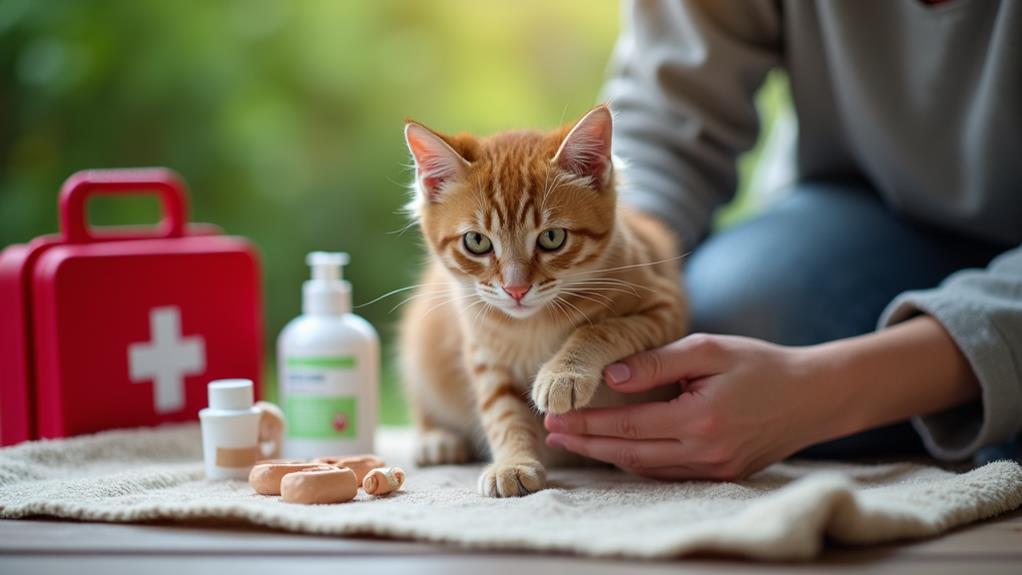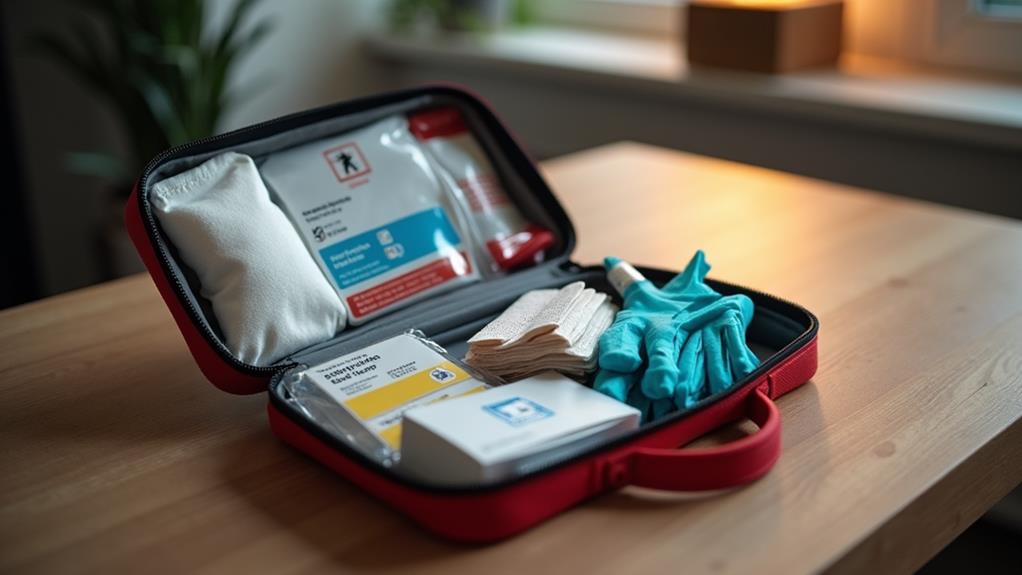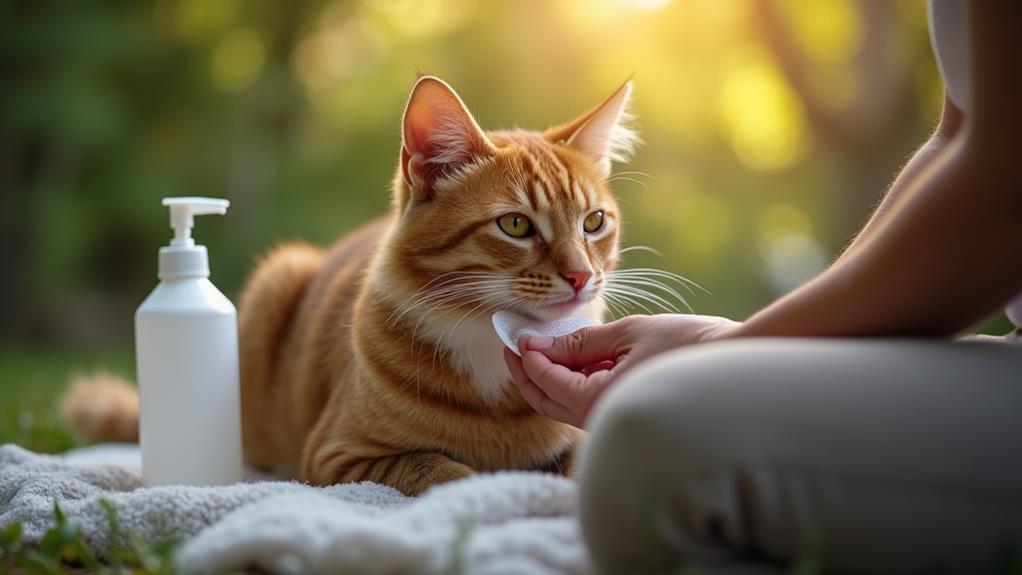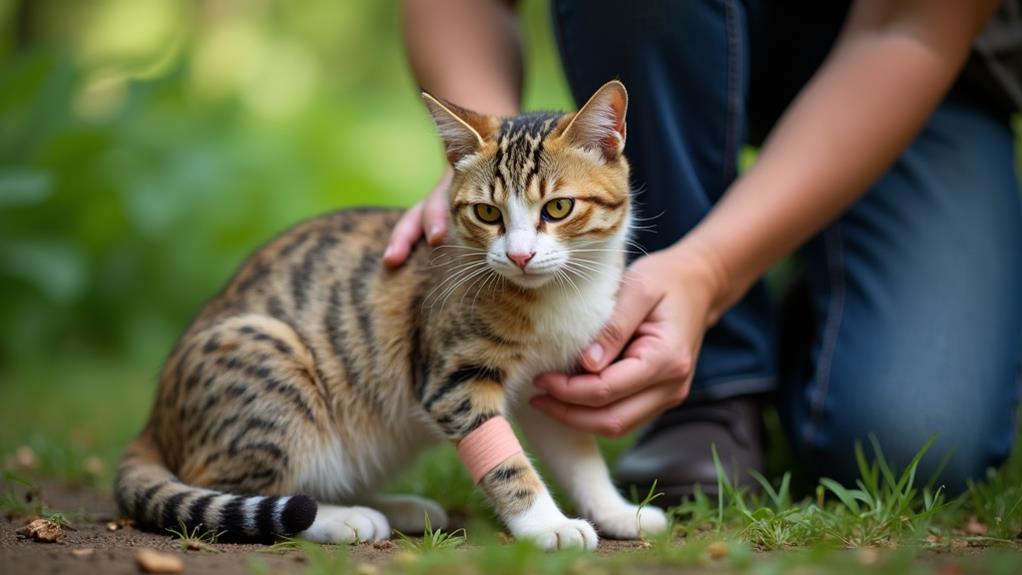How to Treat a Wound on a Feral Cat: Essential First Aid Tips

When treating a wound on a feral cat, initially verify your safety by wearing heavy-duty gloves and approaching the cat calmly. Use a humane trap if necessary. Evaluate the wound's severity and gather vital supplies like sterile gauze, saline solution, and medical gloves. Clean the wound gently, avoiding harsh substances, and apply antibacterial ointment. Secure a bandage without restricting blood flow. It's important to watch for signs of infection such as redness or pus. Confirm the cat has fresh water and nutritious food to aid recovery. Professional veterinary care is highly recommended for effective healing. There's much more detail to uncover.
Prioritize Personal Safety
When treating a wound on a feral cat, your personal safety should come initially. Feral cats can be unpredictable, especially when they're injured or stressed. Always wear heavy-duty gloves to shield yourself from bites and scratches that could introduce harmful bacteria, posing substantial health risks. It's essential to approach these animals with caution and calmness, as their unpredictable behavior may lead to sudden aggression.
Instead of trying to catch the cat directly, use a humane trap to safely contain it. This method minimizes direct contact and reduces the risk of injury to both you and the cat. If you're unfamiliar with handling feral cats, consider reaching out to professional animal control services. They possess the necessary expertise and equipment to manage these situations effectively, ensuring both your safety and the cat's welfare.
Additionally, be aware of the possibility of zoonotic diseases like rabies, which feral cats might carry due to a lack of vaccination. Familiarize yourself with these health risks to stay informed and prepared. Remember, prioritizing personal safety isn't just about protecting yourself—it's about ensuring a safe and humane approach to helping the cat in need.
Evaluate the Cat's Condition
Frequently, before you can treat a feral cat's wound, it's vital to evaluate the cat's overall condition carefully. Begin by observing the cat's behavior. If the cat appears distressed or aggressive, approach with caution as these behaviors may signal pain or fear. Carefully examine any visible wounds. Look for extensive bleeding or deep puncture wounds, both of which might need immediate veterinary care.
Next, check for signs of infection around the wound. Notice any swelling, redness, pus, or a foul odor, as these signs indicate a need for medical attention. Also, monitor the cat's general condition. Lethargy, decreased appetite, or hiding could suggest broader health issues that might complicate the healing process or require veterinary intervention.
Determine the severity of the wounds based on depth and location. If any underlying tissues or organs are exposed, it's vital to seek urgent veterinary care. By thoroughly evaluating the cat's condition, you can make informed decisions about the next steps in wound treatment and guarantee the cat receives the care it needs. Always prioritize the cat's health and safety when assessing its condition.
Gather Essential Supplies

Once you've assessed the feral cat's condition thoroughly, it's time to gather the necessary supplies for wound treatment. Start by assembling a first aid kit specifically tailored for feline care. Key components include sterile gauze and non-adherent bandages to cover wounds without sticking to the skin, reducing the risk of further injury. You'll need medical gloves to maintain hygiene and protect both you and the cat from potential infections.
A sterile saline solution is essential for gently cleaning the wound without causing additional tissue damage. Avoid using harsh substances like alcohol or hydrogen peroxide, as they can irritate the wound. Self-adhering bandages, such as CoFlex®, are perfect for securing dressings in place while allowing the cat to move freely. They conform to the body and don't stick to fur, making application and removal easier.
Blunt-tipped scissors are necessary for trimming fur around the wound, which helps improve cleaning and allows better airflow for healing. Finally, an Elizabethan collar, or recovery cone, is important to prevent the cat from licking or scratching at the wound, ensuring a safer, faster healing process. Gather these supplies before proceeding with treatment.
Approach the Cat Safely
Before treating a feral cat's wound, you must approach it safely to prevent harm to both yourself and the cat. Start by evaluating the cat's behavior from a distance. Is it calm or does it seem agitated? This initial observation is vital. If the cat appears anxious, avoid sudden movements that might provoke it. Instead, approach quietly and slowly. Speak softly to reduce stress and prevent defensive reactions. Wearing heavy-duty gloves is important in protecting yourself from potential bites and scratches, as feral cats can carry harmful bacteria.
If the cat is too distressed or aggressive, consider using a humane trap to safely contain it. This method is often necessary since capturing a feral cat can be challenging without specialized equipment. A humane trap guarantees both your safety and the cat's well-being.
In situations where the cat shows unusual behavior or signs of rabies, it's wise to contact animal control. They have the expertise and tools to handle such cases safely. Remember, your safety and the cat's health are top priorities, so take every precaution. Always be mindful of the risks involved when approaching a feral cat.
Clean the Wound Properly

To clean a wound on a feral cat properly, start by gently trimming any fur around the area using clippers. This helps you see the wound clearly and guarantees a more efficient cleaning process. Next, clean the wound using a sterile saline solution or warm, clean water. Avoid using harsh substances like hydrogen peroxide or alcohol, as these can damage the tissue. The goal is to remove any foreign material and contaminants to help prevent infection.
After cleaning, apply a cat-safe antibacterial ointment. Make sure it's approved by a veterinarian, as some products can cause adverse reactions in cats. Cover the wound with sterile gauze or a non-adherent bandage. This protects the wound from dirt and further injury while allowing air circulation, which aids in healing.
It's essential to monitor the wound daily. Look for signs of infection such as increased redness, swelling, or discharge. If you notice any abnormalities, don't hesitate to seek veterinary care. Timely intervention can prevent complications and guarantee the wound heals properly. By following these steps, you can effectively clean the wound and support the cat's recovery.
Control Bleeding Effectively
After cleaning the wound on a feral cat, it's vital to control any bleeding that may be present. Start by applying firm pressure directly on the bleeding area using sterile gauze or a clean cloth. This helps reduce the blood flow and encourages clotting, which is important for minor wounds. Make sure to apply pressure consistently for several minutes without lifting the gauze to check the wound.
If the bleeding doesn't stop, raise the injured area above the cat's heart level, which can help reduce the blood flow further. In cases where the bleeding continues despite firm pressure, don't remove the initial dressing. Instead, add more layers of clean cloth or gauze while maintaining pressure on the wound.
For severe bleeding, a tourniquet may be necessary if the situation is life-threatening and immediate veterinary care isn't available. However, this should be done cautiously, as improper use can cause further damage. Closely monitor the cat for signs of shock, such as pale gums or lethargy, and seek veterinary assistance immediately if the bleeding doesn't cease. Remember, controlling bleeding quickly and effectively can greatly impact the feral cat's recovery.
Apply a Secure Bandage

Once the bleeding is under control, it's crucial to apply a secure bandage to the feral cat's wound. Begin with a sterile dressing directly on the wound to absorb fluids and prevent infection. This is your initial step in providing effective first aid. Next, add an absorbent layer to cushion the area; this not only protects the wound but also helps keep it dry.
Now, for structural stability, wrap a support layer like rolled gauze around the wound. Confirm it's snug but not too tight, as restricting blood flow could cause complications. You want the bandage to stay in place without causing discomfort or further injury to the cat. The outer layer should be a self-adhering bandage such as CoFlex®, which will hold everything together and guarantee the dressing stays dry and secure, even in diverse weather conditions.
Regularly monitor the bandage for any signs of wetness, slipping, or irritation. Change the bandage every 1-3 days, or follow the guidance of professional veterinary care if available. Properly managing the bandage guarantees the wound heals efficiently and reduces the risk of further complications.
Monitor for Infection Signs
With the bandage securely in place, pay close attention to the wound for any signs of infection. Start by monitoring the area for increased redness, swelling, or warmth, as these are common indicators of infection. Check for any discharge, especially yellow or green pus, which strongly suggests an infection. A persistent foul odor from the wound is another red flag, indicating the need for immediate veterinary attention.
Observe the feral cat's behavior closely. Changes such as lethargy, decreased appetite, or hiding can signal an underlying infection. Cats often try to hide their discomfort, so these subtle shifts in behavior are vital to note. Regularly inspect the wound for excessive bleeding or signs of tissue death, like dry or discolored areas. These conditions require urgent veterinary evaluation to prevent further complications.
Monitoring these signs not only helps in early infection detection but also guarantees that the cat receives timely care. Keeping an eye on swelling, discharge, and any concerning behavior changes will help you act quickly if professional veterinary intervention becomes necessary. Remember, prompt action can make a significant difference in the cat's recovery process.
Ensure Proper Nutrition and Hydration

Proper nutrition and hydration are crucial for a feral cat's recovery. To provide initial aid effectively, guarantee the cat has access to fresh water at all times. Dehydration can slow down the healing process, so keeping the cat hydrated is essential. You might find that offering wet food can also help, as it provides extra moisture for cats that may not drink enough water on their own.
Incorporating high-protein diets is vital for tissue repair and overall recovery. Canned foods are an excellent choice, not only because they are rich in protein but also because they contribute to the cat's hydration needs. Establish a regular feeding schedule to help the cat trust you while guaranteeing consistent nutrition intake. Monitoring the cat's food consumption is significant; if you notice a lack of appetite, it could indicate other health issues that need attention.
Seek Veterinary Assistance
When dealing with a feral cat with a wound, it's critical to seek veterinary assistance as soon as possible. Feral cats often face a host of challenges, including underlying health issues that might not be immediately apparent. By seeking veterinary care, you guarantee that the wound receives professional cleaning and debridement, which are fundamental for proper healing. A veterinarian can assess the injury's severity and determine if surgical repair is necessary.
Infections are a significant concern when treating wounds, especially if they result from bites or scratches from other animals. Be on the lookout for signs of infection such as pus, an abnormal odor, or excessive swelling. These signs require immediate veterinary intervention to prevent complications. A vet can also evaluate the risk of rabies exposure and other zoonotic diseases, providing peace of mind and fundamental treatment.
Veterinary professionals will prescribe appropriate medications, including antibiotics and pain relief, tailored to the feral cat's specific needs. This guarantees not only the wound's healing but also the general well-being of the animal. Don't delay in seeking veterinary care; it's a critical step in supporting the health of feral cats.




